Ventilation elements in a private house. Is ventilation necessary in a wooden house? Forced ventilation device.
Ventilation system in a private house
Ventilation in a private house is installed according to the following algorithm: first we calculate the air exchange and select the cross-section of the air ducts, select the type of ventilation system. Then a ventilation scheme in a private house is drawn up - we determine the installation location of the ventilation equipment, the places where fresh air is taken in and exhaust air is discharged, and the places where the air ducts will pass.
Which ventilation system to choose - natural or mechanical?
For a person’s comfortable stay in the house, it is important not only the presence of fresh air and its temperature, but also the speed of air flow. And the smaller it is, the more comfortable it is to be in the room. The air exchange in a room with mechanical supply and exhaust ventilation (supply and exhaust fans) is greater than in a room with natural ventilation. This is due to the different normalized volumetric speed of air movement in the ventilation system for them. For mechanical ventilation it is 3-5 m 3 /hour, and for natural ventilation no more than 1 m 3 /hour, that is, 3-5 times less. Therefore, natural ventilation of the house creates more comfortable conditions for people.
But there is one “but”, because of which it is sometimes impossible to do without mechanical ventilation. The fact is that the lower the speed of air movement through the channel, the larger its cross-section is needed. For example, if we talk about hood, then in order to pass 300 m 3 /hour of air you will need a channel of 250x400 mm (or 350 mm in diameter) with natural air movement, or a 160x200 mm channel (or 200 mm in diameter) with mechanical hood. It is not always possible to place a large natural exhaust duct in the wall, and moving it outside the wall - under the ceiling or along the wall (as in office premises) is not always aesthetically pleasing in private residential buildings. Therefore, with a large area of the house, it is often necessary to resort to mechanical hood. The flow of air into the room also cannot always be achieved only in a natural way; more on this will be discussed later.
Air flow.
Scheme of organizing flow in a ventilated space
1 - air supply zone
2 - air flow zone
3 - air exhaust zone
Whatever the type of supply and exhaust (natural or mechanical), in order for the air to move freely throughout the house from the supply units to the exhaust units, it is necessary to install flow grilles in the doors along the path of its movement. The flow of air is considered to be organized correctly if the most polluted room in the chain of air movement is the last. That is why the hood is usually installed in the kitchen and bathroom.
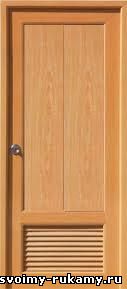
Door with overflow grille
Or leave a gap between the bottom of the door and the floor, at least 20 mm across the entire width of the door.
![]()
Gap under the door for free air movement
If there is no such gap in the doors, then the entire ventilation system in the house can be considered not working. In addition, you will hardly be able to open doors leading to a bathroom without a ventilation grille with a running exhaust fan (due to excess pressure).
Air flow
What causes the air flow, how to understand whether there is enough air in your home and what measures to take to increase the amount of supply air we will consider further.
As already mentioned, air flow can be carried out naturally or forcefully.
Infiltration is a natural influx through leaks in external fences.
(windows, external doors and walls of the house)
![]()
Natural air flow through leaks in window and door openings
As you know, ordinary old-style wooden windows have fairly high air permeability (about 10-20 kg/hour*m2). With a small house area, about 100-140 m2, the volume of supply air penetrating through the cracks and the leakage of such windows is usually sufficient to ensure the necessary inflow. In addition, it is also added to, not so significant, but nevertheless, the flow of air through the leaks of the external doors, as well as the flow through the walls.
Natural influx through ventilation
Ventilation through an open window or crack when the folding frame of a metal-plastic window is slightly opened

Metallo plastic windows in ventilation position
- carries with it large heat losses;
- as a result of such ventilation in winter, the window unit and adjacent slopes cool down, until condensation forms on them;
- air exchange ( complete replacement old air to new) is carried out in 30-75 minutes.
Ventilate with windows fully open.

Ventilation with fully open windows
- rapid exchange of air in the room - only 4-10 minutes;
- there is no cooling effect on structures.
Ventilate with windows and front door fully open.
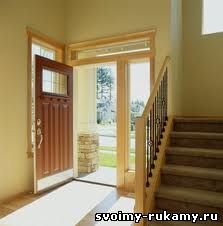
Ventilation by opening all windows and the front door
- draft hazardous to health;
- the fastest possible air exchange - 2-4 minutes when all windows of the house and the front door are opened.
Note.
If it is necessary to ensure a single air exchange in a room (Table 4 DBN V.2.2-15-2005 Residential buildings), this means that within an hour in this room a complete exchange of air for new air must be carried out. And if ventilation is the only source of fresh air in your home (for example, the walls of the house are insulated with airtight foam insulation or EPS and there are airtight metal-plastic windows), then to ensure a microclimate that is comfortable and safe for your health, you must ventilate this room every hour using one of the methods described above. If you see this option as inconvenient or simply impossible for you, then consider installing supply valves, which will be discussed further.
Natural inflow through supply wall and window valves
In the last decade, the installation of windows made of metal-plastic has become very popular, one of the features of which is tightness. And the technology for installing such windows does not provide for leaks to remain. Thus we are deprived of natural influx. The air permeability of metal-plastic windows is no more than 0.1 kg/hour*m2, i.e. practically zero. What to do in such a situation? The solution is simple. Firstly, when choosing and ordering windows, we recommend considering the option of window units with an already built-in adjustable ventilation slot in the upper part of the window frame - a supply window valve.
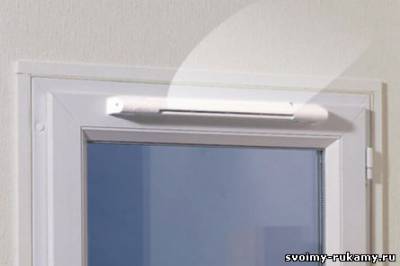
Window with supply valve
If the windows have already been selected, purchased and installed, you can install an air infiltration valve - a supply wall valve.

Wall supply valve
The supply wall valve is a round pipe, which is mounted into the wall (through and through), and is closed with grilles on both sides. The internal valve grid is adjustable from fully closed to fully open. It is advisable to install this valve near window openings, then they can be masked with tulle, and the incoming air will also enter the radiators that are located under the windows.
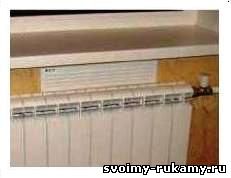
Air flow in the radiator coverage area
For the same purpose, you can install a valve directly behind the battery, then the incoming air will immediately warm up.
![]()
Installing a supply valve directly behind the radiator
Valves can be equipped with filters, as well as humidity and temperature sensors. It is recommended to install dampers in the bedroom, hall and dining room in order to maintain the direction of air movement from clean areas (living rooms) to household areas (kitchen, toilet, bathroom).
The same valves often have to be installed in houses insulated with vapor-proof insulation, such as polystyrene foam or EPS. The walls become vapor-tight, and accordingly the amount of supply air in the house decreases.
Most supply valves supply 50 or 100 m3/h of fresh air. In order to select the required number of valves, you need to calculate the required amount of supply air (L in) using the calculation given in the article Classification and calculation of home ventilation systems.
Forced inflow using suction fans
There are cases when the required air flow is so great that it is necessary to install supply valves under almost every window in the house, but you don’t want to do this, for example, for aesthetic reasons. Then a forced air system is right for you.
The supply system consists of ventilation equipment and a ventilation network. The equipment includes: air valve, filter, heater, fan and silencer. And the network includes the air intake grille, air ducts and air distribution devices (grills, diffusers, anemostats). Equipment set supply ventilation is presented in the figure below. A filter in the supply ventilation system is necessary to remove large dust particles that are present in the street air. Heater - for heating air during the cold season, they are not available in all systems, they are installed at the request of the customer and can be water or electric. When using water heaters, the ventilation system must be additionally equipped with mixing units (hydraulic piping of the heater), which in turn increases the cost of the system.
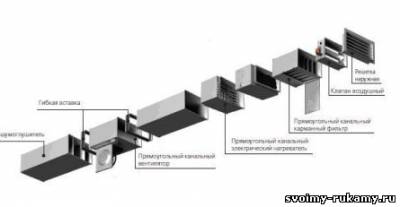
Scheme of a set of equipment for supply ventilation
If the house has mechanical not only air supply, but also air exhaust, then it makes sense to install air recovery system in order to save electricity for heating the supply air. The recovery system will be discussed in more detail a little later.
Air extraction
If the cottage is being built from scratch, then it is necessary to provide for the installation of ventilation ducts in interior walls bathrooms, toilets, kitchens. Channels should be made from brickwork in internal walls (as a rule, they are designed in the architectural section of the project).

Brick ventilation duct
Therefore, exhaust ventilation in a private house is planned before the construction of walls begins. If it is not possible to place ventilation ducts in the wall, then they can be made in the form of attached shafts.

Types of ventilation ducts
a - placement of ventilation ducts in brick wall;
b - ventilation ducts;
c - suspended ventilation duct;
d - output to the roof of the ventilation shaft.
Natural exhaust
If the amount of air that needs to be removed (L out) is small, and the cross-section of the exhaust duct selected from the diagram fits in the wall (or does not fit, but you are ready to make an additional duct), then you can get by with a natural hood. The channel from inside the room, in this case, is simply closed with a ventilation grill.
Mechanical hood
If the cross-section of the channel during natural exhaust is too large, then it can be reduced by making the exhaust mechanical by installing exhaust fans in bathrooms and toilets.
Exhaust fans
There are many types and types of exhaust fans for bathrooms and bathrooms on the ventilation equipment market. The most popular are wall fans, which are mounted on the wall and go directly into the ventilation duct. And fans hidden installation, they are mounted in the ceiling space and are also discharged into the duct through an air duct. We select the fan based on the pre-calculated exhaust flow rate (L exhaust), taking into account pressure losses when air moves through the air ducts. Those. the fan is not selected strictly for the L out number, but with a margin for pressure losses, which sellers of ventilation equipment can usually calculate if you tell them the length and material of your air ducts.
The control of a mechanical hood for bathrooms is often connected to a light switch. Such hoods can be delayed in time, for example, by 50 seconds, after they are turned on (a person has time to wash their hands) or with a delay of 50 seconds after turning off the light. Bathroom fans can be equipped with humidity sensors, i.e. work until normal humidity is established in the room. These hoods are a little more expensive than regular ones.
A completely silent fan, of course, can only be in the off state, but there are fan models that are quieter than others, for example those equipped with noise-reducing rubber-metal bushings. They dampen noise and vibration from engine operation.

Implementation scheme supply and exhaust ventilation in a buiding
1- exhaust fan; 2 - air flow through the leaks of the window opening; 3 - air flow through the supply valve; 4 - flow grille in the doorway.
Ventilation systems with recovery.
Recently, air handling units with energy recovery have become very popular. This is explained by the fact that when fresh supply air enters the house during the cold season, we spend a huge amount of thermal energy heating it. Recuperation systems allow you to save about 50% of heat due to partial heating of the supply (cold) air with the exhaust (warm) air. Partly because the heat of the exhaust air is not always enough to heat the cold supply air to +20 ºС. Therefore, in severe frosts, the supply air is heated by a heater built into the recuperator. In such a system, both the supply and exhaust are mechanical, since air is supplied and removed forcibly by supply and exhaust fans, as can be seen in the figure below.
Operating principle of the recovery system
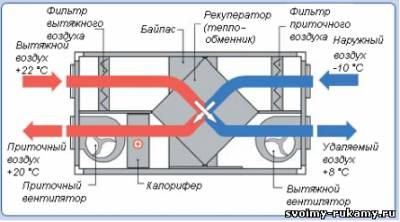
If the house has air conditioning systems, then in the summer the supply air will be partially cooled. This in turn will reduce the load on the air conditioning systems. The operating principle is as follows: the exhaust air cooled by the air conditioning system, passing through the recuperator, cools the warmer supply air.
Location of recovery system equipment
In cottages with a large area, air exchange sometimes exceeds 800m 3 /hour. Consequently, the dimensions of mechanical ventilation units will be large. It is best to decide in advance on their installation location; this could be a technical room in the basement or an attic space. If an attic is selected, it must be insulated to prevent freezing of the coolant and damage to the ventilation equipment (if equipment for internal installation is provided). Below, the figures show examples of the location of ventilation system equipment with recovery in the attic (a) and in the technical room (b).

Figure a. An example of supply and exhaust ventilation in a house with ventilation equipment placed in the attic
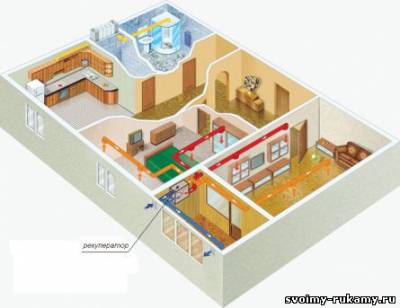
Figure b. An example of supply and exhaust ventilation in a house with the placement of ventilation equipment in a technical room
Types of air ducts.
With option forced ventilation In order to distribute supply air throughout the house and remove exhaust air, air ducts are used (for example, as in the air recovery system in the figure above). Which is better to use an air duct: round, rectangular or flexible?
- Round air ducts with a perfectly smooth surface have the least resistance to air movement, while rectangular ones have more resistance.
- In flexible air ducts, the air resistance is the greatest, due to the uneven corrugated surface. But they are the only ones suitable in cases where the channel turns several times over a short section or when, for example, a kitchen hood needs to be connected to the main (main) channel.
For example, the wiring of air ducts at home can be done as follows: the main air ducts can be made rigid (galvanized), and the branches can be made with flexible corrugated air ducts. Air ducts from the intake grille to the ventilation unit (or to the heater in a dial system) must be insulated to prevent condensation.
Kitchen hood
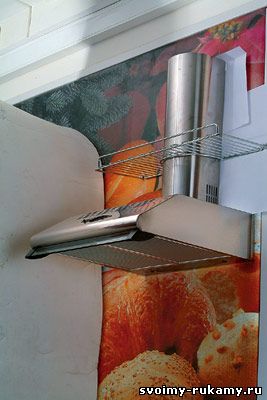
Kitchen hood
Often, when configuring a home ventilation system, the question arises: is it taken into account when calculating ventilation that part of the air is removed by the kitchen hood? No, it is not taken into account. This is due to the fact that the kitchen hood is turned on only occasionally and you simply cannot count on it during downtime. After all, a kitchen hood is designed to remove odors, steam and, first of all, harmful substances at the place of their formation - above the stove.
How to make ventilation in a private house video
Natural ventilation in a private house is a simple system, but it also needs to be understood. You do not need to have any special or professional skills to make this system yourself; you need to know the principle of the ventilation type system itself. You can take care of the ventilation installation in a private house. You can't tell what to do on your own renovation work simple, but still, with a strong desire, it can be brought to life. The ventilation system must be designed correctly; this is the only way it will serve you well. But, despite the correctness of its design, some problems appear over time. If it stops working, a number of problems immediately appear:
- the room is saturated with stale air, which negatively affects the health and comfort of living;
- dampness along with mold begin to attack different corners of your room (very often it is noticed near the gas boiler, bathroom, etc.).
A resident of a private house has its own advantages of living, and it is easier to make ventilation in such a house than for a tenant, so keep this in mind.
- 1 Types of ventilation systems
- 2 Air exchange parameters
- 3 DIY ventilation system
- 3.1 Ventilation options
- 3.2 Materials and equipment for the ventilation system
Types of ventilation systems
Even during Soviet times, apartments and houses that were built then had an expanded ventilation system; there were ventilation holes in every room of the house or apartment. Over time, this trend ceased to be relevant, and such a ventilation hood remained in two rooms: the bathroom and the kitchen. Today, houses are being built with two ventilation holes.
There are only two types of the system under consideration:
- exhaust
- inlet
From the names you can understand what the scheme of these systems is. Exhaust - creating pressure for the air flow to exit the house, supply - creating less pressure inside the room than outside. To create ventilation is to create a pressure difference, and correctly. Airflow requirements:
- laminar movement (uniform, without any vortices);
- there should be no narrow flows, that is, drafts;
- sanitary requirements must be taken into account.
The presence of a gas boiler will help create the necessary conditions. There are building codes for both the creation of sewerage and air exchange. Each type of room has its own air exchange scheme; for residential type rooms, the norm is three cubic meters, and one square meter. For
kitchens and bathrooms - at least sixty cubic meters. You understand why there is such a numerical difference, because you need to take into account the smells of the bathroom sewer, and in the kitchen there is constant cooking, heat from the gas boiler, etc.
Air exchange parameters
The above figures may have surprised you, but remember that with a pipe cross-section of 125 by 125 (air flow speed of 2 meters per second), the air flow through the hood is ensured in a volume of one hundred cubic meters, and this is per hour. To make it clearer, let us explain: with such a flow, if you place a candle near a gas boiler under the exhaust vent, the flame will noticeably move, but you will not feel it yourself.
There is a natural and forced ventilation system. For forced, the most various devices, fans of various models and capacities, depending on the parameters of the ventilated room and sewer odors. Natural ventilation is provided naturally, according to the laws of physics and chemistry: warm air is lighter than cold air, so it is at the top and is removed through various types of openings: ventilation system, window, cracks, etc. Cooler air fills the room by entering through cracks and displaces the lungs.
DIY ventilation system
Ventilation of a private house with your own hands is possible; not a single building can do without it, even if it is an apartment or a house where only one person lives and does not cook. Remember that ventilation is created for normal air exchange in the house, and so that there are no foreign odors from the sewerage system. Before you begin work on reconstructing the old ventilation system, you need to check the pipes that make up the system, figure out which is which so as not to confuse it with the pipes of a gas boiler. If you are completely new to this industry and have no idea what to do, call someone more experienced to help you.
To begin with, check the draft of the ventilation pipe leaving the house; most often it is located near the gas boiler. This is very simple to do, bring a lit candle to the hole and watch the flame. If the ventilation is working correctly, then the flame will deviate towards the ventilation holes, but if it does not move, I assure you that the system is not working. Lack of traction can lead to negative consequences:
- sewer smells are felt;
- fumes and other harmful substances are not removed from the house;
- possible entry into the house of debris that has clogged the pipes or, even worse, some insects.
If you decide to carefully believe everything, then you can take the device from an employee of the SES, who measures the speed of air flow. Specific indicators will be at your fingertips.
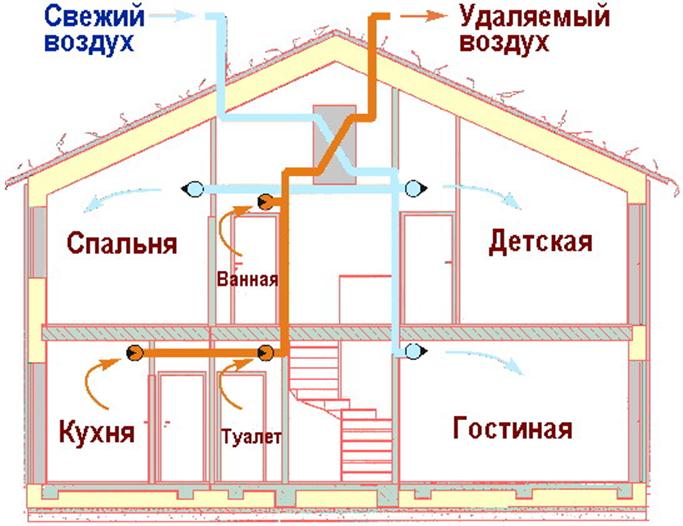
Ventilation options
At your discretion, you can do ventilation in three ways (don’t forget that there should also be ventilation in the basement, because that’s where sewer smells are most felt):
- make ventilation in every room of your house;
- centralized ventilation, with pipes laid around the perimeter of the building;
- hybrid ventilation, that is, some rooms will use a separate system, and some will use a combined system.
Tip: If you are installing a gas boiler in the kitchen, position it correctly so as not to make unnecessary holes in the wall, route the pipes to the outlet through the ventilation holes, that is, into the hood.
In order to organize the first option ventilation system, it is necessary to install fans (they can be mounted in a window, but not near a gas boiler) or in pipes going outside. The second option is very practical and versatile; it is often used in a house where the hood is located under a suspended ceiling, so that the ducts running around the house are not noticeable. If the house is private, then you can install the system in the basement, and the sewage system will not interfere and will not be noticeable. Holes for channels can be made both in the ceiling and in the walls.
Materials and equipment for the ventilation system
Your job is to install the air flow distribution system. For this purpose, rotary type gratings are usually used, which is convenient and drafts are not a problem. In the basement, do not forget to provide ventilation. The fans used to create the system should be adjustable so that you can control the air flow.
You should not make a ventilation box yourself; buy a ready-made one; it is convenient to install it in the basement. Buy such a device made of galvanized steel, it does not absorb sewer odors. The installation process of various structures must be carried out very carefully, because damage to the gas boiler can lead to serious negative consequences. When carrying out ventilation in the basement, you need to take into account the location of the sewer pipes; every detail is important here.
The pipes run around the entire perimeter of the house, so as we said earlier, you want to avoid interfering with any other life support system in your home. When carrying out ventilation near a gas boiler, you should not lean on it so as not to tear it off. If you want your home to be warm during the cold period, install a device - a recuperator, which, in turn, heats the air that enters the house and thermal energy will not be lost.
Sewage odors prevent you from living and feeling comfortable, which means you have problems with ventilation. Even if you have changed the ventilation system throughout the house, you need to check and do it in the basement.
Pipes located in the basement must be checked carefully, because foreign odors may arise due to poor sealing of the pipe; do not forget to constantly check the hood. Ventilation that works without failure is not a luxury, but a necessity. Provide your family with clean and fresh air in your home.
Are you building a house with your own hands and know about all the necessary systems for organizing a healthy microclimate inside the building? This article will discuss do-it-yourself ventilation in a private house. The scheme of work and the choice of components should be thought out as carefully as possible before the start of construction. Otherwise, a discrepancy in the quality of air purification can provoke rapid destruction of the entire building’s finishing, and even cause health problems for all residents of the house.
General scheme for creating ventilation in a private house
The arrangement of ventilation in a private house occurs according to the following algorithm:
- Calculation of air exchange.
- Selection of air duct cross-sections.
- Selecting the type of ventilation system.
- Drawing up a ventilation diagram for a private house with your own hands. These are works such as defining:
- locations of ventilator devices;
- places for fresh collection;
- exhaust air release;
- places where air ducts pass.
Natural or mechanical ventilation system?
In order for a person to feel comfortable in the house, it is necessary to organize and maintain an optimal microclimate. In this case, not only the optimal air temperature is important, but also such an indicator as the speed of its movement.
Important! The lower the speed, the more comfortable the stay in the room. Thus, from a comfort point of view, natural ventilation has an undeniable advantage.
If the house is equipped with supply and exhaust mechanical ventilation with fans installed on the exhaust and air supply, then the air exchange will be more intense than in a living room with natural air exchange.
In this case, the speed of air flow is.
- For natural ventilation- up to 1 cubic meter per hour.
- For mechanical ventilation - from 3 to 5 cubic meters per hour.
However, there are nuances that sometimes make it impossible to do without mechanical ventilation. With a decrease in the speed of movement of the air stream along the channel, the size of the required cross-section increases:
- It is not always possible to place a large cross-section channel in the wall.
- Moving the channel outside the wall, as in some public and office spaces, is not very aesthetically pleasing.
Therefore, there is a need to use a mechanical hood. But it is also not always possible to provide only natural air flow into the room.
Air flow
Let's consider its main sources, as well as measures to increase the amount of supply air. As already mentioned, the flow of fresh air into the room can be either natural or forced. Let's take a closer look at how to make ventilation in a private house with your own hands.
Infiltration
This is air flow through leaks in the walls, windows and doors of the house. If the housing area is small (about 100-140 square meters), and old-style wooden frames are used in the windows, then such natural inflow is quite enough for high-quality ventilation, especially if you take into account the additional air flow through the walls and doorway.
Ventilation
Installation of modern windows with metal-plastic profiles ensures greater airtightness of the room. Ventilation helps solve the problem of air entering the room.
Often they use the installation of a plastic window in the ventilation position. This method has its disadvantages:
- Significant heat losses.
- Cooling of the window block and adjacent slopes in winter time, as a result - the formation of condensation.
Important! Complete air exchange is carried out within 0.5-1.25 hours.
Ventilation using fully open windows does not have the following disadvantages:
- The room is completely ventilated in 4-10 minutes.
- The window structures are not cooled and condensation does not form.
Important! If you ventilate the room with the windows and doors completely open, the air exchange time will speed up to 2-4 minutes, but you must be careful of drafts.
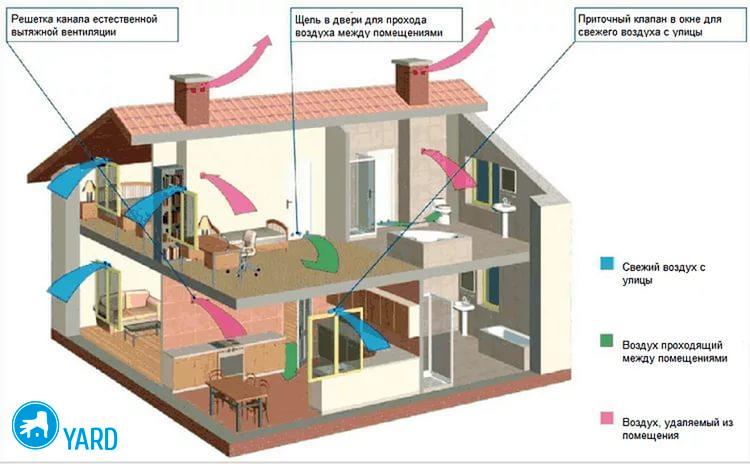
Use of window and wall supply valves
The use of metal-plastic window structures seals the room. Technologies that provide for leaving leaks do not exist. The designers solved this problem by equipping the window structures with adjustable ventilation slots in the upper part of the window.
If you have already installed plastic windows of a “traditional” design, then you can solve the issue as follows:
- By installing wall inlet valves. Wall supply valves are round-shaped pipes that are mounted completely into the wall and closed on both sides with grilles. The internal grilles are adjustable, from closed to open. It is advisable to install valves at window openings so that they can be masked with curtains. In addition, the incoming air in this case enters the radiators located under the windows.
Important! If you install a supply valve behind the battery, the air entering the room immediately warms up.
- The valves can be equipped with filters, temperature and humidity sensors. They are recommended to be installed in the bedroom, dining room and hall, to maintain the direction of air movement: from “clean” rooms to household ones (bathroom, kitchen, toilet).
- Air supply valves have proven themselves well in houses with walls insulated using vapor-proof materials (for example, polystyrene foam, EPS).
Important! The amount of fresh air supplied by the supply valves ranges from 50 to 100 cubic meters per hour. To determine the required number of valves in a house, there is a special calculation method for drawing up a ventilation scheme for a private house with your own hands.
Forced inflow using fans
Sometimes when calculating, it turns out that supply valves will have to be installed under each window. If you don’t want to do this for aesthetic reasons, then the problem can be solved by using forced fresh air from fans.
The do-it-yourself ventilation scheme in a private house (supply system) includes:
- Ventilation network.
- Ventilation equipment.
Ventilation equipment, in addition to the fan itself, includes:
- Noise muffler.
- Filter.
- Air valve.
- Heater.
Important! The filter cleans the incoming air from dust particles. With the help of a heater, the air is warmed up during the cold season (not all systems are equipped with heaters). There are electric and water heaters. Hydraulic heaters are more expensive because their installation involves the additional use of mixing units.
The ventilation network includes:
- Air ducts.
- Air flow distribution devices.
- Air intake grilles.
Important! If the house uses a mechanical method of supplying and extracting air, then to save energy spent on heating, experts recommend installing a recovery system.
Hood
If you are building a house from scratch, then the project needs to include ventilation ducts in the walls of rooms such as the kitchen, bathroom, and bathroom. If it is not possible to arrange internal wall channels, they are made as attached shafts.
There are these types of ducts for ventilation in a private house:
- Internal, placed in a brick wall.
- Add-on channels.
- Ventilation hanging ducts.
- Output to the roof from the ventilation shaft.
Natural air extraction
If the volume of air removal is small, then natural exhaust is sufficient. In the interior of the room, the channel is closed using a ventilation grille.
Mechanical hood
It is used to reduce the cross-section of the ventilation duct necessary for natural air exhaust. Exhaust fans that are installed in bathrooms, kitchens and bathrooms help solve the problem.
The most popular exhaust fans are flush-mounted and wall-mounted.
Important! Fans equipped with air humidity sensors are convenient. Such a device operates until the specified air humidity is established in the room. The cost of such devices is slightly higher than conventional ones.
When choosing a fan, you should pay attention to models equipped with rubber bushings for noise absorption. The device operates with less noise.
Air recovery principle
If the house has an air conditioning system, the air coming from the street is partially cooled. In order to reduce the load on the air conditioner, recuperators are installed. The essence of this principle of arranging ventilation in a private house is as follows: cooled exhaust air passed through a recuperator cools the warm supply air from the street.
Installing ventilation in a private house is a very serious matter, which it is advisable to entrust to specialists. However, the basic knowledge that we shared with you in this article will never hurt.
When building your own home, everything needs to be thought through at the design stage. How deeply and correctly the communications in the house, including ventilation, are thought out depends on how comfortable the inhabitants will feel in it. If the moment of designing ventilation in the house is missed, then this work can be done later. But there will no longer be a guarantee that you will get exactly what you want. Yes, and doing alterations is quite a troublesome and costly task. If a ventilation system for a home is provided during the construction process, then it will be truly easy and comfortable to breathe in, and most importantly, to breathe environmentally friendly air. How to make ventilation in a private house? There are several options to choose from:
- the most common natural ventilation;
- progressive-exhaust, in other words, forced ventilation;
- combination of two types of ventilation (mixed type).
You can select a ventilation system depending on the natural and environmental conditions of your home. If there are forests, lakes and the air is incredibly fresh, then, of course, there is nothing to think about, natural ventilation is installed. If the site for the house is located near some enterprises and its environmental cleanliness is in great doubt, then, naturally, we install forced ventilation with filters. A good owner, when starting any work, advocates first of all for an economical but high-quality result. Let's consider the factors that influence this result. To ensure effective ventilation, attention should be paid to:
- cleanliness of the surrounding air;
- construction material which is used to construct a dwelling.
Houses built from the following materials are suitable for installing natural hoods: timber, brick, adobe, gas block, foam block and expanded clay block. Forced ventilation should be planned for houses made of sandwich panels, frame models and expanded polystyrene concrete.
What is air circulation
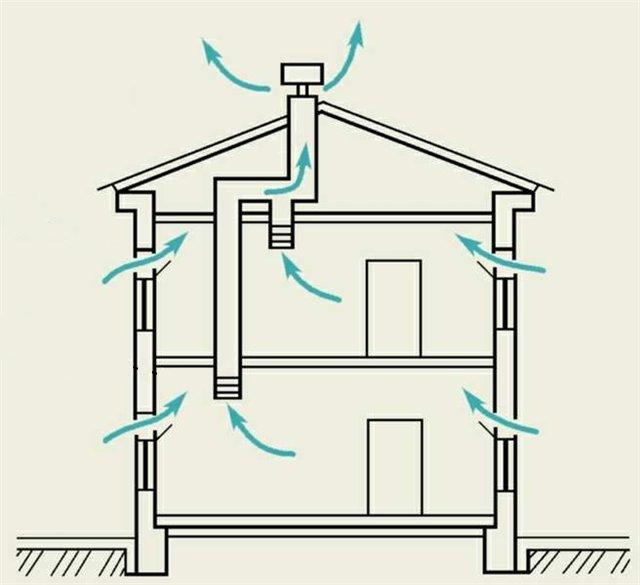
Air circulation consists of:
- air flow - air entering through open windows and doors;
- air flow - air moves through the home;
- air exhaust - air exiting through ventilation holes.
In order for unhindered air circulation to occur, it is necessary to properly install the doors and windows of the home. The doors should contain a small grille, or the installation should be carried out so that there is a gap of about two centimeters at the bottom. Without such holes, air circulation will not occur. The most unclaimed room is usually chosen for the air exhaust device.
Characteristics of types of ventilation
To fully determine the type of ventilation, let’s consider what their essence is:
Natural ventilation
Natural ventilation can be different, but there is one similarity - it occurs naturally.
- Infiltration. This process of air ventilation occurs as a result of air entering through leaky parts of windows and doors. Using wooden doors, which have high throughput air (10-20 kg/hour per square meter). This type of natural ventilation is quite suitable for a house with an area of 100 m2 to 140 m2.
- Ventilation. This process involves the independent entry of air into windows and doorways. But its disadvantage is that heat is lost during the ventilation process. The time to completely fill a home with fresh air is from 30 minutes to 1.5 hours, taking into account the area of the home. If you carry out ventilation in winter, then during the ventilation period the window frame and the adjacent parts of the room cool. This cooling results in fogging and condensation. If you ventilate by opening the windows all the way, the circulation of fresh air occurs in 8 minutes. And if you also open the door, then in 4 minutes.
Important! But do not forget about drafts, they are very dangerous to health.
- Ventilation process using exhaust valves for windows and walls. When replacing wooden windows The metal layer completely stops the air from entering the room. Given this fact, it is best to take a closer look at windows that will have ventilation holes. If it didn’t work out with the windows, then you can make a ventilation hole in the wall. It is a pipe with a diameter of 100 mm, which is mounted through the wall. It is covered with a special mesh outside and inside.
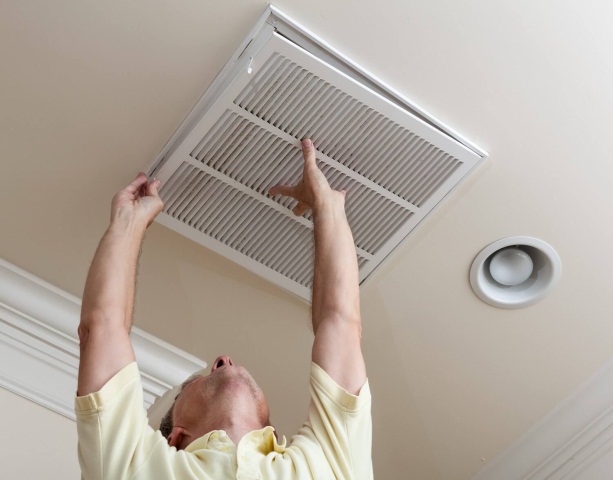
Important! It is best to install such ventilation holes immediately behind the battery so that the incoming air has time to warm up.
Forced ventilation
When wall valves cannot cope with the ventilation process, a forced ventilation system is installed. This system includes ventilation equipment: filters, air valves, a fan, devices for heating air and absorbing noise. It is also necessary to stock up on air ducts and various items that help in air distribution: grilles, diffusers. Don't forget about the air intake grille.
Exhaust ventilation
For installation of exhaust air purification, special channels are designed. They are usually made of brick, so you should think carefully about the design first. Sometimes such a system is installed in the form of additional shafts. They run along the walls of the house. So, exhaust ventilation can be performed in the following options:
- build ventilation shafts in the wall;
- make exhaust ducts in the image of shafts adjacent to the wall;
- install ventilation shafts in the form of hanging ducts;
- bring exhaust ducts to the roof.
Exhaust ventilation can be of natural or mechanical type. Natural type hoods are installed if the intake of clean air is small. In this case, the exit from the ventilation shafts is closed with a regular grille. IN otherwise equip a mechanical hood. For this purpose, special ones are installed at the exits of ventilation shafts. ventilation devices. They are different types. Their large assortment allows you to choose a fan for every taste.
What types of air ducts are there?
When installing various types of ventilation hoods, appropriate air ducts are used. Most often these are air ducts with a round diametrical cross-section. Since the inside of such outlets is ideally smooth, air passes through it without encountering much resistance.
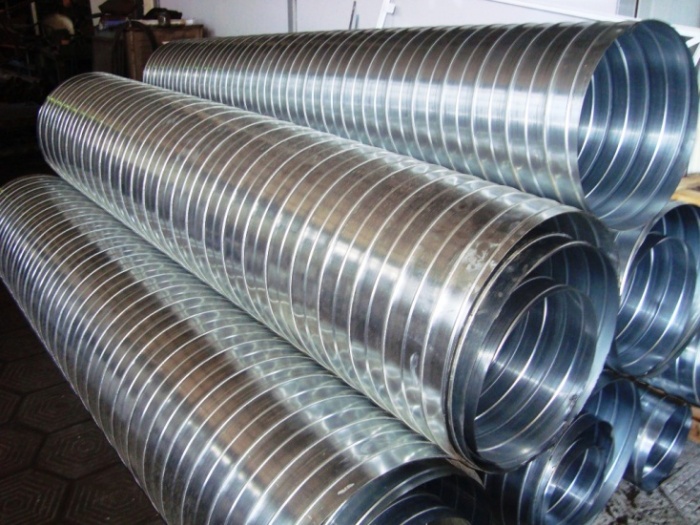
If air ducts with a rectangular cross-section are used, the resistance is higher, but it is easier to install. Often ventilation hood shafts have certain bends, then it is better to use flexible air ducts. They are used if it is necessary to connect two parts of air ducts.
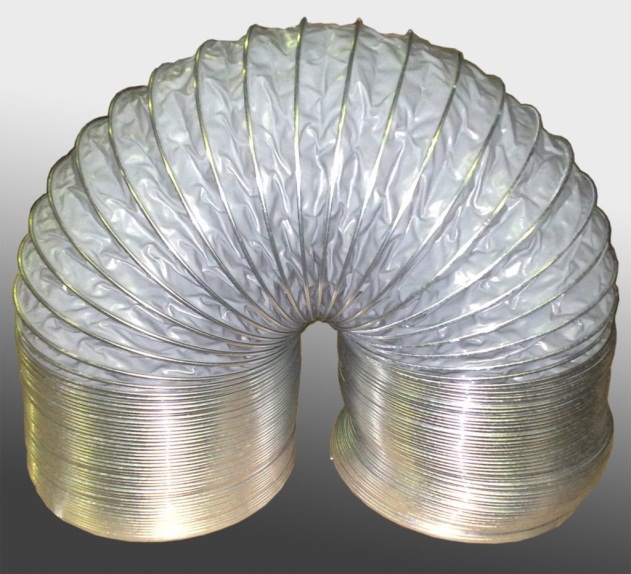
At the connection points, the air resistance is much higher than at other places. Therefore, you should try to make such connections to a minimum.
Ventilation hoods with recovery
The recovery process is the heating of incoming air flows with air at the ventilation outlet. In other words, counter flows exchange heat. This operation allows you to significantly save on heating the street air. But in cold weather, the heat from the output flow is not enough to heat the incoming flow, then you have to use a heater. With such a ventilation system, the exhaust can only be forced. To install a recuperation system, a separate place should be allocated, for example, in the basement.
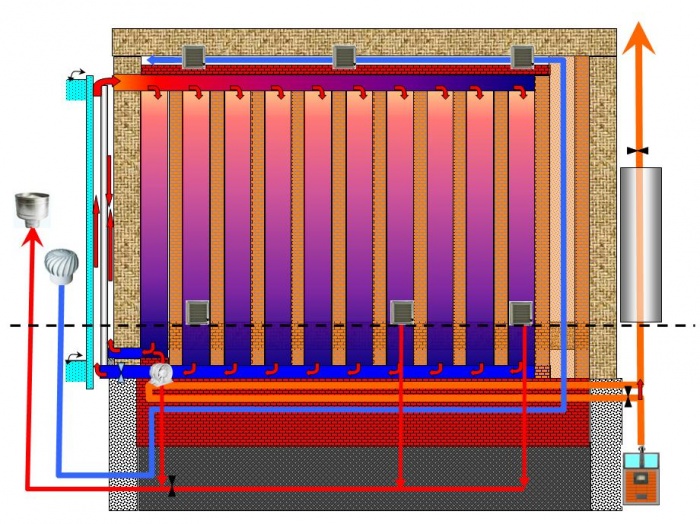
Steps to take when planning ventilation
Whatever the house and the type of ventilation, certain rules should be followed when planning installation:
- First you need to correctly calculate the volume of air exchange. This is the determination of the amount of incoming air that meets all sanitary and environmental standards.
- Calculation of the dimensions of the air duct section.
- Choosing the right type of ventilation hood. To do this, you should take into account all the features discussed above.
- Introducing a plan diagram of exhaust ducts into the design of a private house. If the circuit is drawn up correctly, it will fully ensure good operation.
- Determining the location in the house for installing the ventilation system.
- Selecting a location for air intake and outlet.
- Direct installation of the ventilation system.
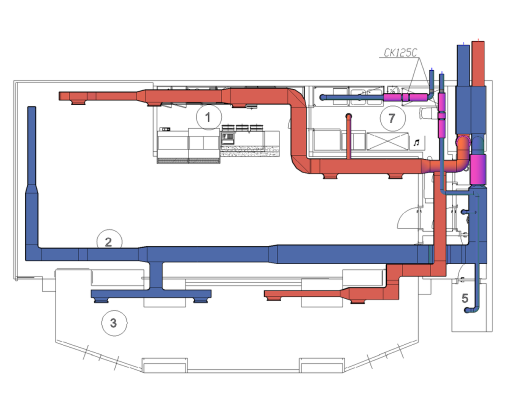
Correctly calculating ventilation
When calculating ventilation, attention should be paid to the main factors:
- How many people will live in the house?
- The actual dimensions of the house.
- How much air can fit in the rooms of the house.
The operation of technical devices, electricity, and hob must be taken into account. All this absorbs oxygen. We also pay attention to which rooms require the cleanest air. For these calculations you can use different ways. Some of them require the presence of professionals to compile tables and diagrams. You can refer to building codes, SNiPAs, GOSTs, etc. In everyday construction, calculations are most often performed based on the area of the house, sanitary standards and multiplicity.
- The easiest way to calculate is by taking into account the area. This method is used for the size of air exchange in a home. According to the standards, three cubic meters of incoming air should be supplied per square meter per hour. The calculation process follows the formula: you should multiply the area of the house by the amount of air according to the norm.
- We calculate using the air exchange rate. This calculation is a little more complicated and uses several metrics. This calculation is usually performed with the help of a specialist. Multiplicity is a value that shows how many times in one hour the air is completely replaced. Standards for this value vary for certain types of premises.
- Calculation taking into account sanitary standards. In this case, calculations are carried out taking into account the norm of the amount of air per person living in the room. The standards are different for each room (for the bedroom, for the kitchen, for the dining room, etc.). As a result, all the data standards are added up and the total volume of air intake is obtained.
We install an exhaust system in the house
We begin installation with the main ventilation shaft. The best place to place it, it is a wall that runs through the center of the house. With this placement, it is easier to connect pipes that act as an air duct from each living room of the house. When planning and installing hoods, horizontal bends should be made as little as possible, as this weakens the draft. As a result, ventilation efficiency is significantly reduced. All branches are ultimately connected to a common pipe, which provides air outlet. It is usually located on the roof.
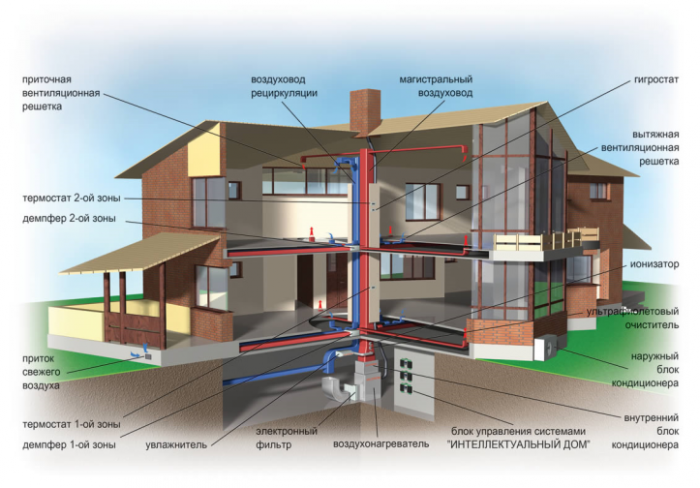
We provide typical hood dimensions:
- The rectangular cross-section of the exhaust shaft in the wall is 13x13 cm.
- The width of the wall that contains the exhaust shaft is 38 cm.
- The exhaust shaft for a heating boiler or fireplace is 13x26 cm.
- The diameter of the pipes used for ventilation is 10-12 cm.
- The height of the exhaust pipe on the roof should be higher than the level of the ridge, and the thickness of its walls should be at least two and a half bricks.
If the wall is made thinner, the air at the outlet will cool very quickly and return back. And if there is not enough height, the traction process will be disrupted.
In addition, you should definitely worry about air flow. If doors and windows are tightly closed and air flow cannot occur, the ventilation system will not be able to operate efficiently. Therefore, you should make sure that there is a gap of about two centimeters wide between the doors and the floor.
So, to ensure proper operation of the ventilation system, many nuances should be taken into account and special attention should be paid to its layout. Only in this case can we ensure fresh air in the house and comfortable living in it.
The issue of building a private house affects a large number of inhabitants of our planet. And each time, due to different circumstances, many different troubles arise associated with its arrangement. Everyone is trying to make it not only beautiful inside and out, but also comfortable for living. In this case, you should seriously think about the proper planning of the internal systems of your private home. It is important to consider all issues at the early stages, since after the final finishing of the house, making changes will be extremely difficult and costly, and sometimes even impossible. In our article we will talk about such an important system as the design of a ventilation circuit. After all, a properly designed system for supplying fresh air to the room will allow you to breathe freely and protect the room from dampness, mold and mildew, which will undoubtedly affect your condition.
Basic types of ventilation for a private home
There are several types of air exchange systems:
- Natural type. Its principle is the exchange of air masses from indoors to outdoors, thanks to the laws of physics. The air flow is directed through special channels, due to wind pressure and pressure changes depending on height.
- Forced ventilation system. Based on the operating principle of air exchange auxiliary equipment. It also has a name - supply and exhaust.
- Mixed ventilation system. As a rule, this is a combination of forced and natural systems.

All options have both their advantages and disadvantages. For example, would it make sense to install forced ventilation if you live in an ecologically clean area with excellent air? A modern filtration system will not allow you to enjoy the fragrant air of your area. The filter will fulfill its role, and the air will indeed be purified, but do you need it if it is already clean? It's another matter if your a private house located in a region with a polluted environment. No one wants to breathe industrial exhaust gases or other air pollutants. Therefore, filtration is simply necessary. How to plan everything correctly and determine what is best for your case?
Basic conditions for choosing the type of ventilation in a private house
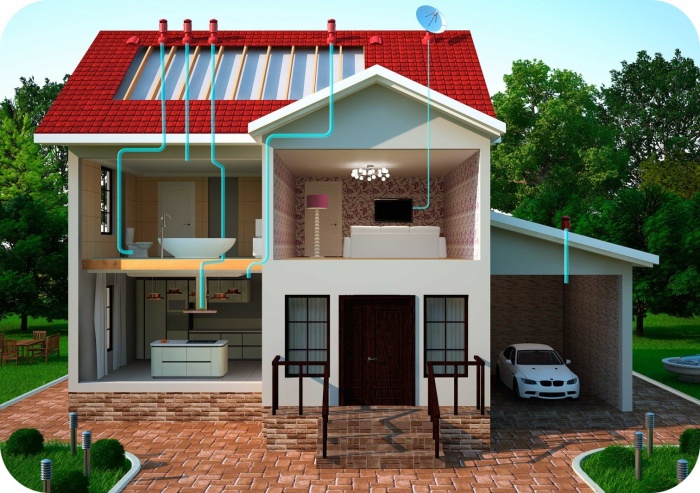
In order not to waste funds, the issue of ventilation should be considered at the planning stage of the structure. You need to rely on the following data:
- Object location, conditions environment;
- Materials used in the construction of your private home.
Based on this data, a choice should be made.
Natural ventilation will be the optimal solution under the following conditions:
- The ambient air is not polluted;
- The materials of the house are as follows:
- Tree;
- Brick;
- Adobe;
- All types of foam concrete;
- Ceramic and expanded clay blocks;
- Expanded clay concrete.
Mixed type ventilation will be recommended when the natural system cannot provide proper air exchange. In this case, additional forced air exhaust systems can be installed. Such premises could be a kitchen or a workroom. In these cases, the refusal of a forced exhaust system will affect the atmosphere of the entire house. Unpleasant odors and grease can spread throughout all rooms.
Compulsory system
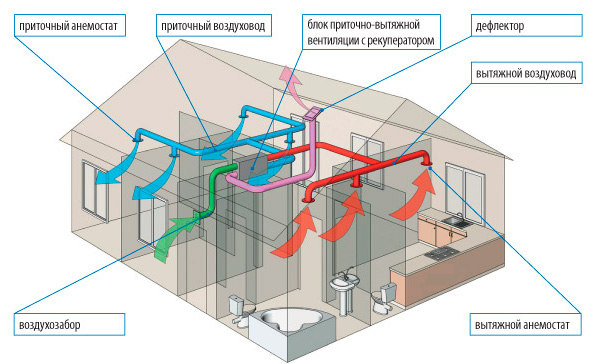
A supply and exhaust unit, as well as a filtration system, must be installed in the following cases:
- Incoming air from the environment needs to be pre-cleaned from harmful dust particles and odor;
- The following materials and technologies were used:
- 3D panels;
- Concrete using expanded polystyrene;
- SIP, MDM, SOTA, sandwich and vacuum panels;
- Frame type houses.
In these cases, forced ventilation will be the most effective solution.
Benefits of natural air circulation
Nowadays, many people prefer to use only supply and exhaust ventilation and miss the opportunity to use natural ventilation. It also has its advantages:
- Equipment costs are lower;
- When installing correct scheme ventilation in a private house, you will have the opportunity to regulate air exchange in rooms, and even heat those where there are no heating devices. These could be landings, passage corridors, flights, etc.
- The freshest air will fill the necessary living spaces;
- An optimal level of indoor humidity is maintained.
Installation of ventilation in a private house with your own hands

In order to try to independently organize ventilation systems in your home, you need to correctly calculate everything and weigh your strengths in this rather complex matter. When installing this type of system, some knowledge will be required.
To start calculating your system, you need to take into account the total number of people in the entire house and the volume of the premises themselves.
Advice! It is also necessary to take into account those things that additionally consume oxygen in the room.
In addition, it is worth considering the fact that some rooms will require more frequent air exchange than others.
Regardless of what kind of room you have, to install ventilation with your own hands you need to follow the following plan:
- Calculate the volume for air exchange;
- Determination of cross-sections of ventilation shaft channels;
- Decide on the type of ventilation system used;
- Drawing up a diagram of the location of ventilation ducts;
- Determining the location of the main components and devices;
- Determining the location for air intake and exhaust from a private home.
All necessary calculations must be made in accordance with current GOST and SNIP in the sections on ventilation of a private house.
All these calculations can be done independently. Thus, it is necessary to calculate the following values, and then, comparing them, choose the larger one:
- Calculation of air exchange, taking into account the number of people living:
L = N * Lnorm, where
L—required forced ventilation capacity, m³/h;
N—number of residents;
Lnorm - air consumption rate per person:- at rest (sleep) - 30 m³/h;
- typical value (according to SNiP) - 60 m³/h;
- Calculation of air exchange by frequency:
L = n * S * H, where
L — required ventilation capacity, m³/h;
n is the normalized air exchange rate:
for residential premises - from 1 to 2, for offices - from 2 to 3;
S—room area, m²;
H—room height, m;
According to the results obtained, it will be possible to determine the necessary materials and the cross-section of air channels, as well as select air distributors.
Requirements for ventilation systems in private houses
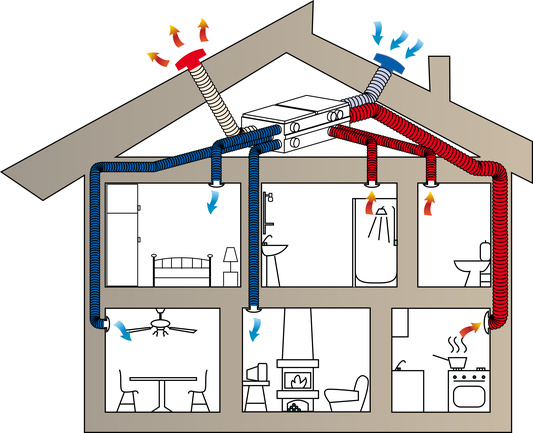
Exist general rules, following which you can achieve the desired result:
- Air exhaust from the ventilation must be done on the roof. The height of the ventilation exhaust grille must be regulated by SNiP;
- Using mechanical devices of ventilation systems, air must be taken through special grilles;
- The direction of air flow should be from the cleanest rooms, through dustier ones, to the exit.
Natural air exchange system through ventilation
Such room ventilation can also guarantee you an additional opportunity to obtain fresh air, but there are some peculiarities of this method.

Window in “ventilation” position
All modern window systems can be equipped special fittings to set the window to the ventilation position. But this method has the following disadvantages:
- In this position of the window, a large amount of heat escapes from the room;
- In winter, condensation may appear on the slopes of the window unit due to its rapid cooling;
- There is a rapid replacement of air from the room and vice versa.
Ventilation with the window fully open
In cases with a window in the fully open position, this method will have the following features:
- Rapid air exchange throughout the entire room in a few minutes;
- In winter it is impossible to use due to large heat losses.
- There is no cooling effect on the entire structure.
Ventilation with a fully open window and open door
Such air exchange can be characterized by the following features:
- If you need to very quickly ventilate the room in a matter of minutes;
- A “draft” may form, which is harmful and dangerous for the body;
- Complete loss of room heat.
Do-it-yourself forced ventilation in a private house
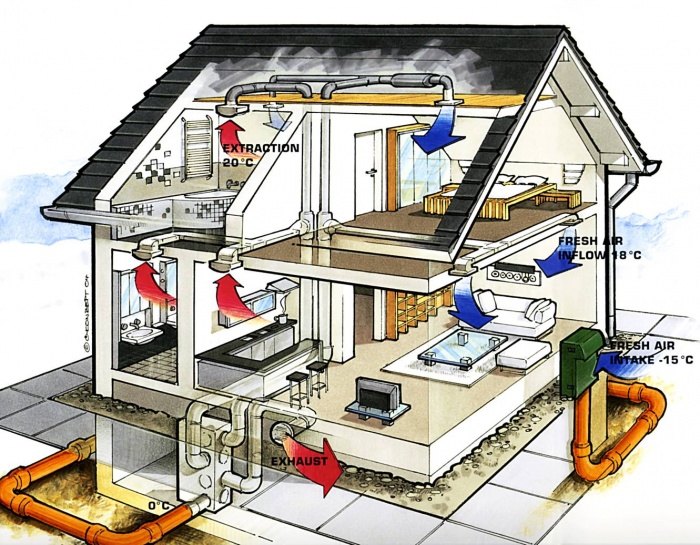
If there is no natural ventilation in a private house, or it does not cope with the task in some rooms, it is necessary to additionally install forced ventilation.
Installing additional equipment in toilets and bathrooms will help eliminate the appearance of mold and mildew on the walls and ceiling as a result of condensation accumulation. In this case, installation is usually carried out wall fan. This will solve the problem. Unfortunately, this will require additional costs, and not everyone will like the operation of the cooler itself. When the fan blades rotate, they create noise, so some manufacturers have begun to recommend bearingless fans that operate on a hub. Their service life is much shorter, but it will be more comfortable to be in the room. The fan can be turned on electrical diagram, which will allow you to control it either by turning on the switch key separately, or in conjunction with the lighting.
Issues of installing ventilation in the kitchen are resolved by installing both methods. A forced air exchange system is located only at the installation site of cooking surfaces to remove odors and combustion products from saturation of the air with them.
High-quality ventilation must necessarily have an influx of fresh air in the right quantity. But in order to clean the environment when the environment is polluted, it is necessary to install special filters. This will allow you to get maximum results. Do not forget that filters tend to become clogged with dust and debris. They should be replaced with new ones in time, or cleaned. Otherwise, bacteria may begin to multiply inside it, and along with the air they can enter the room. Thus, the room will become even more polluted.
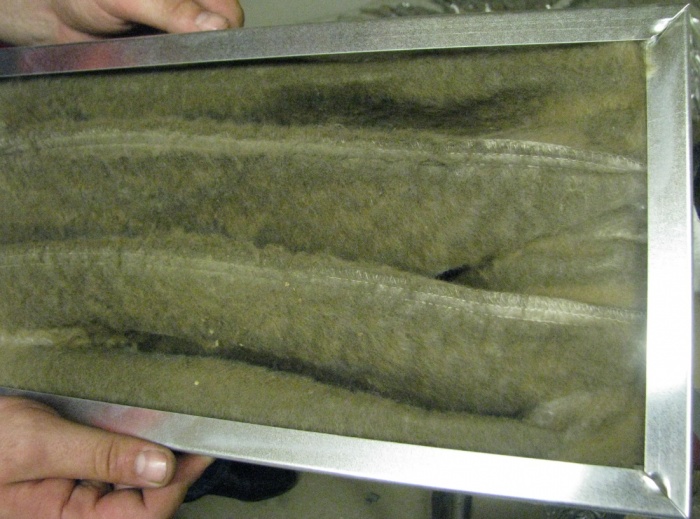
Conclusion
To summarize, it’s worth saying that if you want to install a ventilation system with your own hands in a private house, then you will need to plan everything correctly and follow the following rules:
- Installation of ventilation shafts in all living rooms using special channels for natural air exchange;
- Availability of supply and exhaust ventilation in rooms such as the kitchen and bathroom with toilet;
- Installation of additional ventilation ducts when organizing fireplaces or stove heating in the house;
- A combination of natural and forced ventilation systems in the kitchen, with installation of a hood above the hob.
